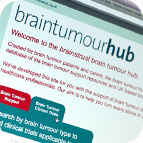 Driven by patient demand for more information on current and upcoming clinical trials in the UK, brainstrust has launched an easy-to-use, up-to-date and comprehensive database which everyone can access.
Driven by patient demand for more information on current and upcoming clinical trials in the UK, brainstrust has launched an easy-to-use, up-to-date and comprehensive database which everyone can access.
Only 10.8% of brain cancer patients signed up for a brain tumour clinical trial in 2010/11
And only 1.1% of those were for randomized clinical trials. This is, in part, due to the lack of clinical trials in brain cancer. If more funding was put into researching this disease then the picture would be very different because more brain tumour trials would equal more patients and therefore more results.
So what are we going to do about it?
To help promote activity in this area we’ve done some more work and developed The Brain Tumour Hub to include an easy to navigate, comprehensive database of UK brain tumour clinical trials – allowing patients more visibility of what trials are taking place – which we hope will lead to more awareness of the need for research and in turn more funding.
The Brain Tumour Hub (www.braintumourhub.org.uk) already hosts a database of brain tumour support services and now also lists all upcoming and current brain tumour clinical trials. The navigation allows the user to search for brain tumour clinical trials by brain tumour type and answers an unmet need for a ‘one stop shop’ for patients who are interested in volunteering to be part of a study.
The content itself has been produced in collaboration with the National Cancer Research Institute (NCRI), neuro healthcare professionals and researchers from across the UK. The information is not only easily accessible by visitors who can just click to apply to become part of a trial but it is also easily updated and added to by the researchers themselves.
And what do the experts think?
Commenting on the launch of the Brain Tumour Hub, Colin Watts, Clinical Senior Lecturer in Neurosciences at Cambridge University said,
“Information empowers patients by placing themselves firmly at the centre of their own care; it also empowers clinicians by helping them to direct patients to resources that can help them fight brain cancer and recruit into clinical trials. The Brain Tumour Hub is a significant contributor to this enhanced process of care and is to be welcomed”
brainstrust director, Helen Bulbeck, adds,
“When patients are initially diagnosed they are desperate for information, support and advice on their condition which is why we set up our charity brainstrust. With our new Brain Tumour Hub database of clinical trials we are offering patients the chance to take control of their illness in a simple way which offers much needed reassurance at a very challenging time. We also know that accrual rates for clinical trials are low so having this information easily accessible should help address this.”
Our supporters
The Brain Tumour Hub has a big team of people behind it – not only our advisors from ‘the brainstrust’, but we are in constant consultation with the wider clincial and research community. We’ve also been fortunate enough to have support and funding from the Nominet Trust, an initiative that contributes to a safe and accessible internet used to improve lives and communities.
To see the Brain Tumour Hub in action, simply click here to visit www.braintumourhub.org.uk








